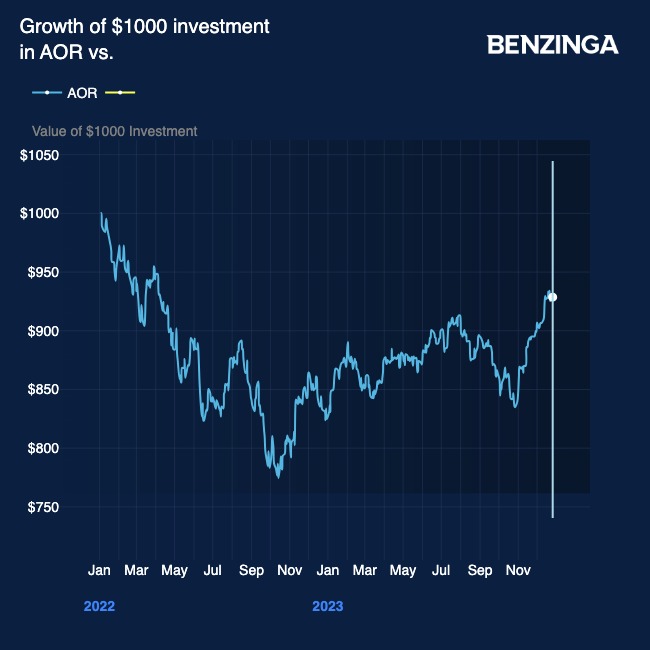Zinger Key Points
- In 2023, the 60/40 portfolio rebounded impressively, marking its third-best year since 2008 after a lackluster 2022 performance.
- Investors are assessing 2024's outlook as the 60/40 portfolio shows strength, but the future hinges on potential rate cuts
- China’s new tariffs just reignited the same market patterns that led to triple- and quadruple-digit wins for Matt Maley. Get the next trade alert free.
The traditional 60/40 investment portfolio has recorded a remarkable year of growth in 2023, sharply rebounding from a disappointing year in 2022. As of Dec. 27, the year-to-date performance of the 60/40 portfolio, benchmarked by the iShares Core Growth Allocation ETF AOR, stands at approximately 13%.
This performance figure ranks as the third-best year for the strategy since its inception in 2008, trailing only behind the strong years of 2009 and 2019.
As we enter the new year, investors are pondering whether the favorable conditions that supported both equities and bonds in the second half of the year will endure.
60/40 Portfolio In 2022-2023: From Downturn to Upswing
The 60/40 portfolio is a time-tested investment strategy known for its simplicity and effectiveness. It involves allocating 60% of the portfolio to stocks and 40% to bonds, with the aim to strike a balance between risk and reward.
Stocks offer the potential for higher returns but come with higher risk, while bonds generally provide lower but more stable returns. By combining both asset classes, the portfolio naturally diversifies, potentially reducing the risk of significant losses since stocks and bonds often react differently to market conditions.
In 2022, the traditional 60/40 portfolio faced one of its most challenging years due to the Fed’s aggressive interest rate hikes, which created strong headwinds for both equities and fixed-income assets.
The gauge fell as much as 17%, wiping out a sizable portion of the pandemic rally.
An initial $1,000 investment in a 60/40 portfolio at the beginning of 2022 dipped to less than $800 by November of that year, only to rebound to its current value of $928.

However, as inflation subsided in 2023, traders began to anticipate a normalization of elevated interest rates, betting on the Federal Reserve reducing borrowing costs in 2024.
Money markets currently factor in six rate cuts by 25 basis points next year, a figure substantially higher than the indications given by Federal Reserve officials at the latest meeting, with the dot-plot showing a median preference for 75-basis-point cuts.
Read also: Why The 60/40 Portfolio Rule Is NOT For Everyone – The Statistics Might Surprise You
Will the 60/40 Portfolio Continue to Rally in 2024?
Looking ahead to 2024, it remains to be seen whether the numerous rate cuts currently priced in by the market will be delivered by the Federal Reserve.
If these rate cuts materialize, bond yields are likely to continue heading lower, benefiting fixed-income assets and potentially rate-sensitive stocks such as those in the technology, real estate, and financial sectors.
On the other hand, if the decline in inflation stalls or fresh pressures emerge, the Federal Reserve may find it inappropriate to deliver as many rate cuts as currently expected by market participants.
This could lead to disappointment in the markets and potentially weigh on both equities and bonds.
In summary, the 60/40 portfolio has made a strong comeback in 2023, but its performance in 2024 will depend on whether the anticipated rate cuts materialize and how economic factors evolve.
5 Strategies to Create a 60/40 Portfolio
Aside from the iShares Core Growth Allocation ETF AOR, there are several other ways for investors to construct a 60/40 portfolio.
Here are seven different approaches an investor can use to replicate a 60/40 portfolio, with each pairing a stock ETF with a bond ETF:
- S&P 500 ETF Trust SPY and iShares 20+ Year Treasury Bond ETF TLT: Combining SPY, which tracks the S&P 500 Index, with TLT, focusing on long-term U.S. Treasury bonds, offers a balanced portfolio with exposure to the U.S. stock market and the stability of government bonds.
- Vanguard Total World Stock ETF VT and iShares Core U.S. Aggregate Bond ETF AGG: VT provides global stock market exposure, while AGG tracks the U.S. Aggregate Bond Index, diversifying bond exposure.
- iShares MSCI ACWI ETF ACWI and Vanguard Total International Bond ETF BNDX: ACWI offers global equity exposure, and BNDX focuses on non-U.S. bonds, providing international diversification.
- iShares Core S&P 500 ETF IVV and Vanguard Total Bond Market ETF BND: Similar to SPY, IVV tracks the S&P 500, and BND provides diversified exposure to the U.S. bond market.
- Vanguard Total Stock Market ETF VTI and Vanguard Total World Bond ETF BNDW: VTI offers exposure to the entire U.S. stock market, and BNDW provides a globally diversified bond exposure.
Read now: Treasury ETF And Real Estate Sector Rise Together As 30-Year Yields Dip Below 4%
Photo: Shutterstock
Edge Rankings
Price Trend
© 2025 Benzinga.com. Benzinga does not provide investment advice. All rights reserved.
Trade confidently with insights and alerts from analyst ratings, free reports and breaking news that affects the stocks you care about.